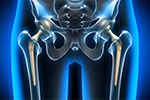Occasional soreness is part of the game in young athletes, but persistent or recurring hip pain shouldn’t be ignored. Ongoing hip pain could signal an underlying issue that, if left untreated, may lead to more serious injury, irreparable damage to the joint and permanent or extended time away from the sport. Here’s why early evaluation matters.
Hip Pain Isn’t Always Just a Strain
It’s easy to dismiss hip pain as a pulled muscle or tightness, especially in active teens and college athletes. But the hip is a complex joint, and persistent discomfort could indicate deeper structural problems—like femoroacetabular impingement (FAI), instability, labral tears, or early cartilage damage. These conditions are often overlooked or misdiagnosed as soft tissue strains.
Pain in the front of the hip or groin, clicking or locking sensations, or discomfort with running, squatting, or prolonged sitting should never be ignored, especially if symptoms last more than a couple of weeks.
Why Early Diagnosis Matters
Delaying diagnosis can allow minor issues to progress into more serious conditions. For example, untreated FAI can eventually lead to labral damage, cartilage injury or early arthritis. By identifying the root cause of hip pain early, athletes can avoid prolonged recovery times or even the need for major reconstructive surgery later on.
A hip specialist can use advanced imaging, such as specialized X-rays, MRI or 3D CT scans, to assess bone shape, soft tissue health, and joint mechanics, allowing for a more accurate diagnosis and tailored treatment plan.
Non-Surgical Treatment Options Are Available
Not all hip injuries require surgery. In fact, many young athletes respond well to conservative treatments such as physical therapy, anti-inflammatory medications, activity modification, and guided rehabilitation. The goal is to reduce inflammation, improve joint mobility, and correct imbalances that may be contributing to the issue.
When surgery is necessary, minimally invasive procedures like hip arthroscopy can repair labral tears or reshape bone to relieve impingement, usually with excellent outcomes and a high rate of return to sport.
Performance Depends on Joint Health
Athletes put tremendous stress on their hips whether sprinting down a field, launching off a diving board, or pivoting on the court. Ignoring pain can alter movement patterns and lead to compensatory injuries in the knees, back, or in the other hip. Addressing hip issues proactively protects overall performance and long-term health.
If hip pain persists for more than two weeks, worsens with activity, or interferes with your sport, schedule a consultation to explore treatment options tailored to your goals and activity level. Early evaluation can make all the difference in your recovery and your future on the field.
AUTHOR: Etan Sugarman, MD, is a board-certified, fellowship-trained orthopedic surgeon specializing in joint preservation and sports medicine. He has extensive expertise in minimally invasive techniques, complex primary procedures, and using the latest surgical technologies and biologics to improve outcomes and recovery. Prior to joining the American Hip Institute, Dr. Sugarman was a member of the Center for Regenerative Orthopaedic Medicine at Lenox Hill Hospital in New York City.





